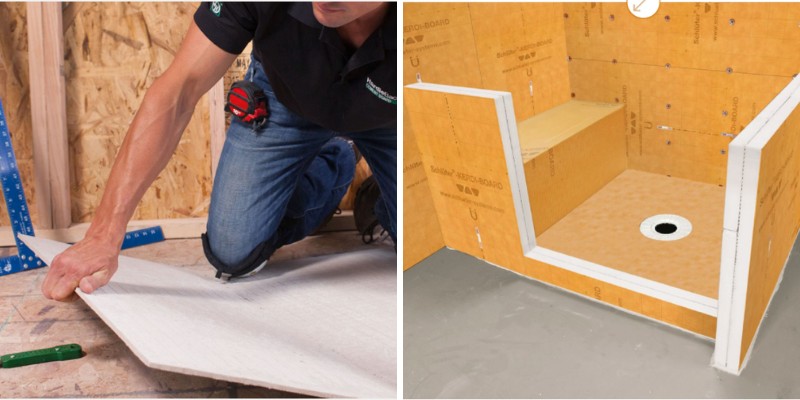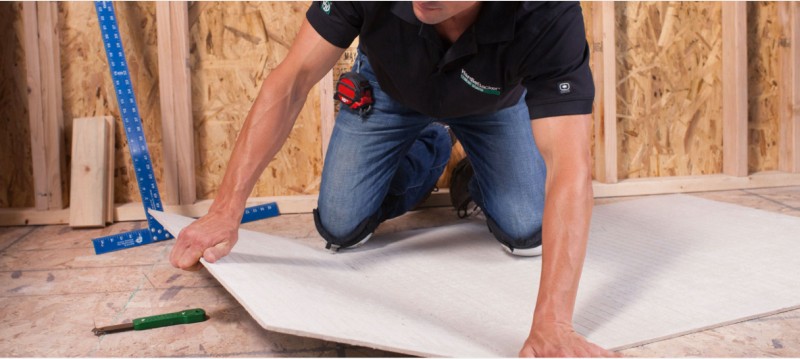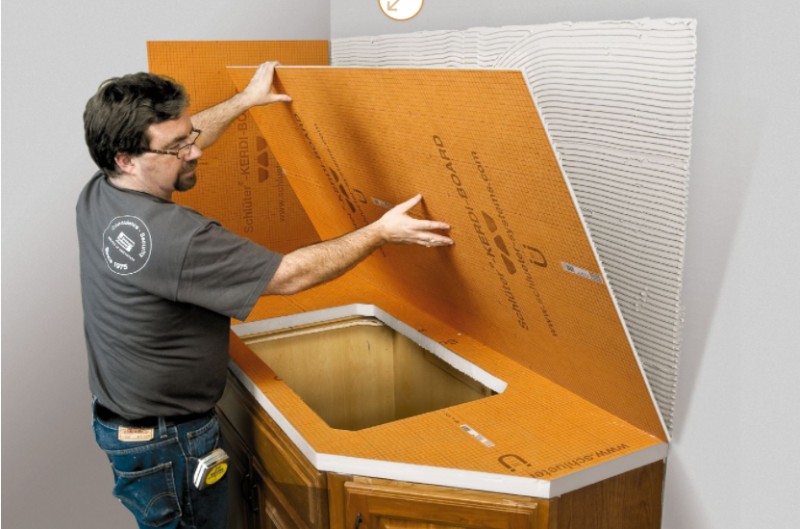Contractor Steve Gehrmann has been in the bathroom construction and renovation business so long; he can tell you all about the beginnings of wall boards that were traditionally made of aggregates of Portland cement reinforced with fiberboard.

This commonly-used construction component has been around since the 1950s — until significant amounts of moisture began infiltrating tile and grout—especially if that grout wasn’t sealed.
Research and innovation lead to the development of 4 types of tile backer boards designed exclusively for use in showers (and other wet areas in the house):
- cement board;
- fiber cement board;
- glass mat tile backer board and
- foam board, a material that may have either of two coverings: cement-coated and membrane-coated.
Of the four types, we discuss two of the most popular by brand: Hardie Backer Cement Board (fiber cement) and Schluter Kerdi Board (foam).
Let’s see in more details the comparison between Hardiebacker vs Kerdi board and their characteristics with pros/cons when used in home tiling projects.
Pros and Cons of Fiber Cement Board
Pros
- -Offers the permanence and strength of cement.
- -Available in ¼-inch and ½-inch thicknesses for many use cases.
- -Comes in varying price points for all budgets.
Cons
- -Tends to be more brittle than standard cement board
- -Heavier than other types of board
- -Can be hard to cut and breaks more easily.
Pros and Cons of Foam Board
Pros
- -Super lightweight compared to other types
- -Easy to cut with rudimentary tools
- -Polyisocyanurate core is waterproof thus no surface membrane is needed.
Cons
- -Can fail if board is directly exposed to water
- -It’s critical to waterproof seams for best results
- -Fastener penetration can compromise waterproofing.
Hardie® Backer Cement Board
This fiber cement board product is known for its unique cement content of 90-percent Portland cement and sand and no loose filler or aggregate is used to manufacture it.

Tested and found to have superior flexural strength – up to 3-times that of competitive boards – it can be cut to size simply by scoring and snapping, leaving clean edges for the install.
Generating less dust and debris when cut, Hardie® Backer Cement Board is a breeze to install and due to the unique materials used to construct this product, installers enjoy excellent tile adhesion.
Preferred for its ability to offer long-term moisture and damage protection, this product’s proprietary HydroDefense™ technology was the subject of a 2019 contractor market study that showcased this brand’s outstanding characteristics.
Among the reasons contractors prefer this product over others is because it passed ANSI A118.10 standards for waterproofing with flying colors.
Pros
- -Versatile and lower weight compared to pure cement boards.
- –Superior to Durock when combined with other materials.
- -Easy to sever the pre-cut squares.
Cons
- -Can’t withstand low temperatures (i.e can’t be used outside).
- -While Hardie Backer is water repellent it isn’t waterproof.
- -Must be used in tandem with waterproof sealant or a comparable product.
Schluter Kerdi Board
If a foam product meets your criteria for the best way to create a base for the tile you’ll mount in your new bathroom, take a close look at Kerdi Board, a product of Schluter, a business operated by Werner Schluter since 1966.

This waterproof, multi-functional tile substrate and building panel is known for ensuring moisture protection within bonded waterproofing assembles that host tile.
These versatile boards are made of extruded polystyrene foam covered with fleece webbing that tightly bonds tile to the surface.
Kerdi Board gives contractors lots of flexibility, encourages creativity, it’s impact-resistant and rigid in addition to being one of the lightest materials on the market.
Once installed, it provides stability, thermal insulation and waterproofing and since Kerdi Board isn’t made with cement or fiberglass, dust-free installation is assured.
Pros
- -Exceptional structural rigidity and ready-made for mortar application.
- -Foam core and covering match those used in the high-end boating industry.
- -Won’t deteriorate as a result of exposure to moisture.
Cons
- -Getting the Kerdi membrane to embed could be problematic
- -Make sure thinset isn’t too stiff or not stiff enough to create a bond
- -May run into wicking issues during the install.
Comparison of Hardie Backer vs. Kerdi Board
Having done a thorough review of opinions published online by contractors, we found a high degree of preference among them for both products and many of these resources are brand loyal.
To make your decision, consider their reasons for choosing one over the other.
Choose Hardie Backer if:
- -You don’t mind the fact that these boards are heavy and bulky.
- -You prefer using products made with certified Portland cement.
- -You like having myriad board size options at your disposal.
- -You are looking for a cheaper product to undertake your job.
- -You are willing to install a plastic barrier behind the backer board.
- -You find Hardie Backer’s grid measurements to be invaluable.
- -You prefer a stiffer, harder product for your projects.
- -You don’t insist upon clean cut edges when severing sections.
- -You are willing to use a product that soaks up water yet dries without losing form.
Choose Kerdi Board if:
- -You undertake solo jobs and seek the lightest weight backer board on the market.
- -You prefer a product reinforced on both sides with a fleece webbing material.
- -You undertake jobs where a variety of panel thicknesses may be needed.
- -You find it easy to cut and score this product because it saves time.
- -You don’t want to have to install a barrier between the tile and Kerdi Board.
- -You seek a manufacturer’s warranty from a respected company like Schluter.
- -You want the best chance of installing in one day and tiling on the next.
- -You prefer a backer board offering insulating properties not found in cement board.
- -You’re fastidious about the uniformity of edges after sections are cut.
- -You seek a 100-percent waterproof medium for your bathroom project.
General Comparison of Cement Boards vs. Foam Backer Board types
For starters, while there is only one general foam backer board type, there are several hybrid cement backer board types.
The most basic is cement, boards made of inorganic materials and crafted with lightly aggregated Portland cement with fiberglass reinforcement.
Cement backer boards offer both fire- and impact-resistance. Newer products contain polymers and may feature a fiberglass mesh sheath. It’s the heaviest and hardest to cut.
Fiber cement board, on the other hand, offers the most versatility since different manufacturers use unique materials to make their proprietary backer board.
Less brittle, more flexible, and lighter due to the inclusion of cellulose fibers and silica sand or gypsum, this type of board resists mold, moisture, and mildew.
According to a large number of contractors, the best reason to choose fiber cement board is its ability to resist compression.
These products tend to weigh less than cement-only boards yet they’re hefty enough to require a modicum of strength when transporting and installing them.
Alternately, extruded polystyrene foam boards literally changed the tile backer board industry and remain the leading material in terms of the amount of research being conducted on new ways to produce this product.
In addition to being the lightest backer board on the market, foam is extremely flexible and malleable, especially products in this category that are composed of high-density polyisocyanurate closed-cell foam.
Foam backer board coverings are becoming more diverse. At present, most foam backer boards are encased in layers of fleece, fabric, or cement.
Not only are foam backer boards extremely water resistant, but this can’t be stated often enough: These products are, on average, 80-percent lighter than average cement boards, a factor that contractors don’t take lightly when they’re on the job alone.
Some Kerdi Board Alternatives
Wonderboard with Redgard
RedGard® Waterproofing and Crack Prevention Membrane is a “ready-to-use elastomeric waterproofing membrane for both commercial and residential tile and stone application.”
Appropriate for exterior and interior substrates, KERDI forms a continuous waterproof membrane known for its outstanding adhesion properties.
Further, crack transmission within tiles and/or stone floors is reduced as a direct result of that tight bond.
Since Wonderboard alone doesn’t offer waterproofing protection, this bonded pairing produces a solid seal that won’t allow water to penetrate tiled bathroom walls.
GoBoard®
This Johns Manville bathroom wall product is an ultra-lightweight, waterproof, durable option that is easy to cut and install. Because it weighs up to 85% less than traditional cement board, it’s a favorite of contractors on tight schedules because it also makes possible same-day tiling.
Only a standard utility knife is needed to cut GoBoard for installation and workers aren’t inundated with dust while this product is being cut and handled.
Further, installation time is cut dramatically since GoBoard is already waterproofed, so not only is it safer and lighter, but installation is faster since contractors need only seal board joints and fastener sites.
Wedi board
Yet another option for contractors or DIY homeowners undertaking bathroom wall and tiling projects, Wedi board consists of a blue core crafted of extruded polystyrene foam that is infused with glass fibers on both sides to create an alkali-resistant seal that is then coated with polymer-modified cement.
Ideal for laying tiles, slabs, and even natural stone, Wedi board offers moisture protection, a modicum of heat insulation and it is approved for interior installations like swimming pools and steam baths in addition to bathrooms. It’s versatile, lightweight, stable, and ideal for projects that incorporate thin-bed application methods.
Some Hardiebacker Alternatives
Denshield
The iconic Georgia-Pacific brand includes among its most popular products Denshield, a backboard that is being marketed as “the first backer board with a built-in moisture barrier.”
Denshield is designed to absorb less water than competitor fiber cement alternatives and it cuts and installs just like drywall, so no special fasteners or tools are required to do the job.
Originally engineered as a sub-floor/wall cavity moisture protector that serves as backup protection should grouted tile be penetrated, contractors who rely upon this brand of backer board use it for new construction underlayment, bathroom remodels and in other high-humidity or moisture prone areas.
Fiberock
Made in the U.S.A. by the United States Gypsum Company (USG), Fiberock is especially popular among installers interested in using sustainable building materials.
It is composed of 95% certified recycled content. Relying upon the product’s reputation for superior water resistance, flexibility, and strength, Fiberock® Brand Tile Backerboard panel construction is unique, in that the fiber-reinforced interior is where the water-resistant core is located rather than an exterior membrane or coating.
Unlike traditional gypsum, Fiberock isn’t made with facing paper that can scratch, tear, or de-laminate. Fiberock is adhesive, resin and solvent-free, so it’s ideal for vinyl floor installs in addition to bathroom walls.
The mold-resistant surface stands up to all types of moisture assaults, requires no additional tools for installation and Fiberock’s superior tile bond is three times stronger than minimum industry standards.
Resources
https://redblockindustries.com/blog/shower-remodel/shower-tile-backer-board/
https://www.familyhandyman.com/list/which-tile-backer-is-best/
https://www.jameshardie.com/products/hardiebacker-cement-board
https://upgradedhome.com/kerdi-board-vs-cement-board/
https://kennedykitchensandbaths.com/best-backer-board-tile/
https://www.diytileguy.com/shower-tile-backer-board/
https://www.homerepairtutor.com/an-easier-alternative-to-cement-board/
Related Posts
- Comparison of HardieBacker Cement Board vs Plywood For Tiling Projects
- 6 Great Alternatives to HardieBacker Cement Board
- Comparison of WonderBoard vs GoBoard Used as Tile Backer Boards
- How Much Does it Cost to Furnish a House – Living Room,Bedroom,Kitchen etc
- 5 Benefits of Spray Foam Insulation During Summer
- Here are Some Plumbing Installation Tips For your New Home
thank you for the educational essay. at my age, i want to convert tub/shower to walk in shower. with an eye to economy, i would like to use the Delta classic 60x32x 74 acrylic surround with tile redi pan, which obviates the need to hot mop. My alcove is not quite 60 inches, hence the redi pan as customs can be ordered and I prefer the slip- protective of a tiled floor. The Home Depot website had the Kerdi waterproof surround lusted to acrylic wall kits but i thought acrylic was a nonporous surface not penetrable by water if intact. Can you advise on this plan and whether high gloss acrylic wall would pair well with Festival 2 inch porcelain floor tiles with black sanded grout. Thank you.
Sorry le, I don’t have the answer to your specific questions.
I prefer not to advice you on something so specific that I don’t know for sure.